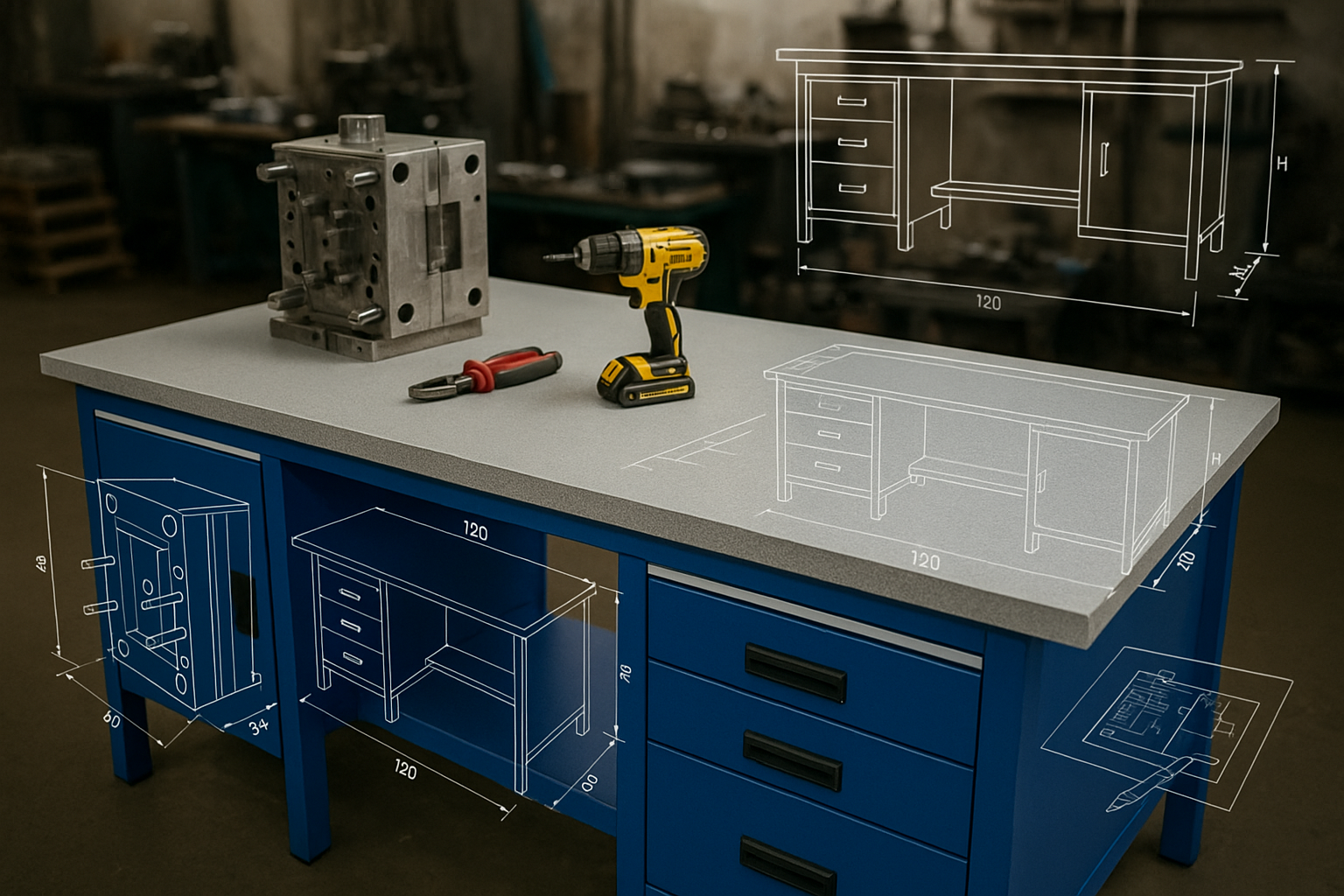The Heart of the Workshop: Durability and Ergonomics
When you think of a tool shop, the first things that come to mind are massive molds, heavy parts, and an intense workload. But who’s the hidden hero carrying all that weight? Special workbenches. 😊
Choosing the wrong bench doesn’t just hurt efficiency—it can also put workplace safety at risk.
It happened to me once: I tried using an ordinary workshop bench in a tool shop. It worked fine for a few weeks, but then the surface started bending. That’s when I realized a bench designed specifically for tool shops isn’t just an investment—it’s a necessity.
1. Workbench Models Used in Tool Shops
1.1 Heavy-Duty Steel Frame Workbenches
- Pros: High load capacity, resistant to vibration, very long lifespan.
- Cons: Very heavy, hard to move or relocate.
- Best Use: Large mold processing and assembly.
1.2 Aluminum Profile Workbenches
- Pros: Lightweight, rust-free, adaptable with modular add-ons.
- Cons: Lower load capacity compared to steel.
- Best Use: Medium-sized parts, areas requiring quick setup.
1.3 Wood-Covered Surface Workbenches
- Pros: Doesn’t scratch workpieces, absorbs vibration, more ergonomic.
- Cons: Can deform quickly under heavy metalwork.
- Best Use: Assembly and maintenance of delicate parts.
1.4 Hydraulic or Mechanical Adjustable Workbenches
- Pros: Height-adjustable, ergonomic, reduces operator fatigue.
- Cons: Higher cost.
- Best Use: Long-term assembly and maintenance tasks.
2. Comparison Table
| Workbench Model | Advantages 🚀 | Disadvantages ⚠️ | Best Use Scenario |
|---|---|---|---|
| Steel Frame Workbench | Extremely durable, very high load capacity | Heavy, hard to move | Heavy molds, industrial work |
| Aluminum Profile Workbench | Lightweight, modular, rust-free | Not as strong as steel | Medium-scale work, quick setup |
| Wood-Covered Surface | Non-scratch, ergonomic, absorbs shock | Wears out faster with metals | Precision assembly tasks |
| Hydraulic/Mechanical Adjustable | Ergonomic, adjustable height | High cost | Long assembly processes |
3. Advantages of Using the Right Workbench
- Safety: Prevents heavy parts from falling or tipping.
- Efficiency: Proper height and layout speed up workflow.
- Ergonomics: Reduces operator fatigue and strain.
- Durability: Long-lasting material means long-term investment.
- Professionalism: A proper bench builds trust with clients visiting the workshop.
4. “The Price of the Wrong Bench”
One of my supervisors once told me: “We placed a mold on a regular table. The leg broke, the mold fell, and not only was the material damaged, but production stopped for days.”
From that day on, only special workbenches were used in the shop. Sometimes what seems like an expensive investment is actually the most economical solution in the long run.
5. Ideal Workbench Layout for Tool Shops
[ Top Surface ]
- Wood cover / metal sheet (depending on the task)
[ Middle Section ]
- Drawers (for small parts)
- Shelf modules (for hand tools)
[ Bottom Section ]
- Steel frame, heavy load support area
- Options for wheels or fixed legs
6. Golden Insights 🌟
- Heavy jobs = Steel frame
- Medium jobs = Aluminum modules
- Precision work = Wood surface
- Ergonomics = Height-adjustable bench
- Right choice = Safer, more efficient, longer-lasting workshop
The Right Workbench Is a Necessity, Not a Luxury
Special workbenches are the hidden heroes of tool shops. The wrong choice risks safety and disrupts workflow. The right choice:
- Ensures workplace safety.
- Boosts efficiency.
- Saves money in the long term.
My advice: choose your bench based on load, precision, and ergonomic needs. That way, your tool shop will be not only safe but also highly productive. 🚀
 English
English
 Türkçe
Türkçe 
